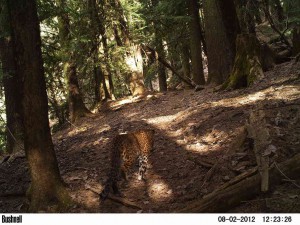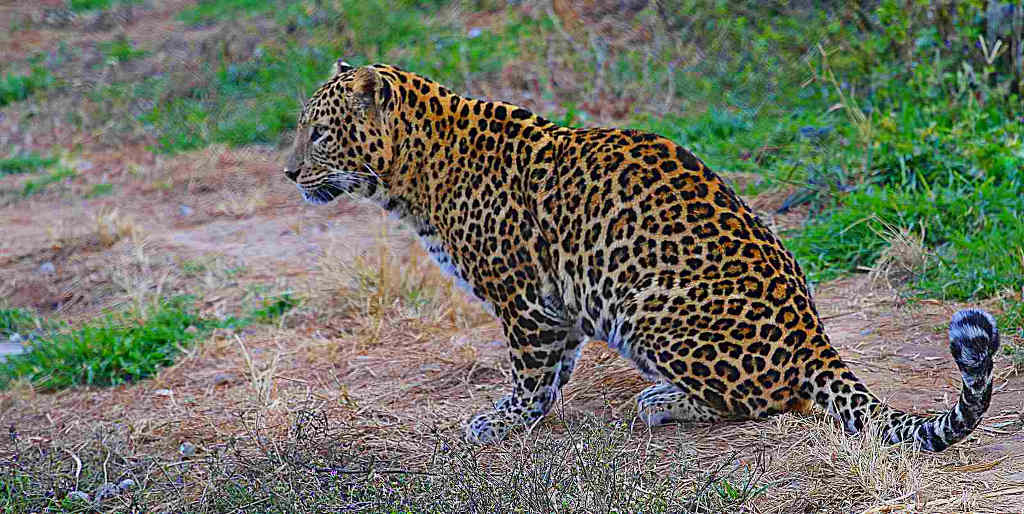
Common leopard (Panthera pardus)
The Common Leopard (Panthera pardus) is one of the most adaptable and elusive big cats found in the Great Himalayan National Park (GHNP). As a top predator in the park’s mid-elevation forests, the common leopard plays a crucial role in maintaining ecological balance.
Physical Description
The common leopard is known for its muscular build, spotted golden-yellow coat, and piercing gaze. Unlike the snow leopard that roams GHNP’s higher altitudes, the common leopard thrives in lower to mid-altitude forests ranging between 1,500 to 2,800 meters.
Its rosette-patterned coat provides excellent camouflage, enabling it to stalk prey unnoticed through the park’s dense vegetation.
| Common name | Common leopard |
| Latin name | Panthera pardus Linnaeus 1758 |
| Local name | Cheeta bagh |
| IUCN/WPA/Indian status | Near threatened/I/Occasional |
| Social unit | Solitary |
| Size / weight | HBL : 203-243 cm(male) 180-208 cm (female), HAS: 50-70 cm TL : 76-106 cm. WT : 45-77 kg(male) 30-45 Kg (female) |
| Description | The most adaptable big cat of the Indian subcontinent the leopard has a clear yellow coat marked with black rosettes. It has a small spotted head, powerful jaws and a long tail, and its underside is white. The normal colour of the coat varies considerably in intensity from gold to tawny. The rosettes are unique in individual leopards like the stripes of a tiger. They are more like large spots(solid) on the limbs and the face, and on the body they turn into rosettes with a dark tawny centre as compared to the background. The eye like tiger’s are forward facing and large but eyesight may not be the most powerful sense of the leopard. It uses its hearing and smell more in survival. |
| Behavior | The rasping call of the leopard (called sawing because it resembles the sound of wood being sawed) is a familiar nocturnal call of the Indian jungle and Himalayan foothills. Leopard manage to coexist with tigers by hunting smaller prey( they tend to go for prey that weigh between 10-15 kg.) and hauling carcasses up trees. They also prey upon cattle, dogs and even children at times thus earning notoriety as man eaters As they are often sighted near habitations in rural India. |
| Distribution | Throughout India except the arid parts of Kutch and Rajasthan and the high Himalayas (up to 3000 m.) |
| Habitat | Deciduous and evergreen forests, scrub jungle, open country and fringes of human habitation.There are recent studies that have shown that leopard have colonized erstwhile human habitation( such as sugar fields) and are using them as habitat to breed and feed. Such leopards are therefore, no longer to be considered as stray from the jungle. |
| Best seen | Gir NP, Sanjay Gandhi NP Borivili (Mumbai) Maharashtra |
Behavior and Habitat in GHNP
Solitary and nocturnal by nature, the leopard is most active at night or during dawn and dusk. In GHNP, it prefers temperate broadleaf forests, but it is also known to navigate rocky outcrops and grassland edges. It is an opportunistic predator, feeding on barking deer, langurs, wild boar, and occasionally livestock near the buffer zones.
Despite being at the top of the food chain, it avoids encounters with humans and larger predators like the snow leopard.
Conservation Status and Threats
Although the common leopard is listed as Vulnerable by the IUCN, it is still widely distributed across India. However, threats like habitat fragmentation, human-wildlife conflict, and poaching have put pressure on its population. Within GHNP, the species benefits from strict protection, habitat continuity, and minimal human interference.
Importance to the Ecosystem
As a keystone predator, the leopard helps regulate herbivore populations, thus contributing to the ecological balance of GHNP’s forests. Its presence also indicates a healthy, functioning food web within the park’s ecosystem.




